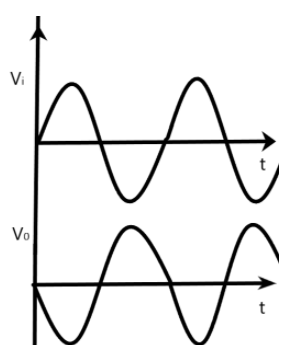
Answer
449.7k+ views
Hint: The transistor can be connected in a circuit in different configurations. The output characteristics as well as the input characteristics vary with these configurations quite noticeably. We can use the knowledge on these to find the required solution.
Complete answer:
The transistor is a three-terminal device, also known as Bipolar Junction Transistor. It has a large and moderately doped collector, small and least doped base and a medium-sized and highly doped emitter. An external bias applied to a NPN transistor is shown below. We can see that the base-emitter junction is forward biased and the base-collector region is reverse biased.

The CE configuration is used as a switch in the appliances. As the input voltage, \[{{V}_{i}}\]in the circuit is applied, the current from emitter to the base increases due to the forward bias, but the current (electron flow) to the base will be less as the base is doped very lightly. The reverse bias at the base-collector will result in the lower output voltage, \[{{V}_{0}}\]. As the input voltage increases, the transistor acts as a switch and therefore, the output voltage decreases. This is the switching mechanism involved in this. Also, when the input voltage is lowered, the output voltage is peaked. This change in the voltages, i.e., the input voltage and the output voltage are directly proportional but the direction is opposite. From this fact we can conclude that the CE configuration produces a phase change of \[\text{18}{{\text{0}}^{0}}\] which causes the output voltage to decrease or increase with the increase or decrease in input voltage respectively.

From the above figure, we understand the simultaneous input and the output voltages of the transistor in CE configuration.
We understand that the phase difference between the input voltage and the output voltage is \[\text{18}{{\text{0}}^{0}}\].
The correct answer is option C.
Note:
The transistor characteristics are used widely in many appliances with different properties. The switching property is used in devices which require to off and on accordingly. The amplified signals for better transmission are also achieved using transistors.
Complete answer:
The transistor is a three-terminal device, also known as Bipolar Junction Transistor. It has a large and moderately doped collector, small and least doped base and a medium-sized and highly doped emitter. An external bias applied to a NPN transistor is shown below. We can see that the base-emitter junction is forward biased and the base-collector region is reverse biased.

The CE configuration is used as a switch in the appliances. As the input voltage, \[{{V}_{i}}\]in the circuit is applied, the current from emitter to the base increases due to the forward bias, but the current (electron flow) to the base will be less as the base is doped very lightly. The reverse bias at the base-collector will result in the lower output voltage, \[{{V}_{0}}\]. As the input voltage increases, the transistor acts as a switch and therefore, the output voltage decreases. This is the switching mechanism involved in this. Also, when the input voltage is lowered, the output voltage is peaked. This change in the voltages, i.e., the input voltage and the output voltage are directly proportional but the direction is opposite. From this fact we can conclude that the CE configuration produces a phase change of \[\text{18}{{\text{0}}^{0}}\] which causes the output voltage to decrease or increase with the increase or decrease in input voltage respectively.

From the above figure, we understand the simultaneous input and the output voltages of the transistor in CE configuration.
We understand that the phase difference between the input voltage and the output voltage is \[\text{18}{{\text{0}}^{0}}\].
The correct answer is option C.
Note:
The transistor characteristics are used widely in many appliances with different properties. The switching property is used in devices which require to off and on accordingly. The amplified signals for better transmission are also achieved using transistors.
Recently Updated Pages
10 Examples of Evaporation in Daily Life with Explanations

10 Examples of Diffusion in Everyday Life

1 g of dry green algae absorb 47 times 10 3 moles of class 11 chemistry CBSE

What is the meaning of celestial class 10 social science CBSE

What causes groundwater depletion How can it be re class 10 chemistry CBSE

Under which different types can the following changes class 10 physics CBSE

Trending doubts
Fill the blanks with the suitable prepositions 1 The class 9 english CBSE

Which are the Top 10 Largest Countries of the World?

How do you graph the function fx 4x class 9 maths CBSE

Differentiate between homogeneous and heterogeneous class 12 chemistry CBSE

Difference between Prokaryotic cell and Eukaryotic class 11 biology CBSE

Change the following sentences into negative and interrogative class 10 english CBSE

The Equation xxx + 2 is Satisfied when x is Equal to Class 10 Maths

Why is there a time difference of about 5 hours between class 10 social science CBSE

Give 10 examples for herbs , shrubs , climbers , creepers




